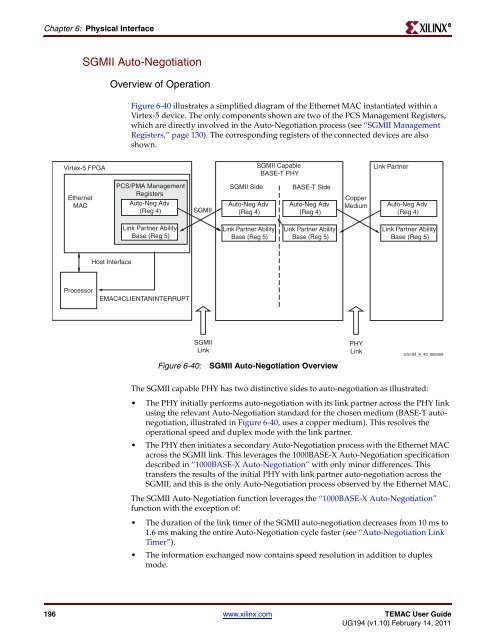Xilinx UG194 Virtex-5 FPGA Embedded Tri-Mode Ethernet MAC ...
Xilinx UG194 Virtex-5 FPGA Embedded Tri-Mode Ethernet MAC ...
Xilinx UG194 Virtex-5 FPGA Embedded Tri-Mode Ethernet MAC ...
You also want an ePaper? Increase the reach of your titles
YUMPU automatically turns print PDFs into web optimized ePapers that Google loves.
Chapter 6: Physical Interface<br />
SGMII Auto-Negotiation<br />
<strong>Virtex</strong>-5 <strong>FPGA</strong><br />
<strong>Ethernet</strong><br />
<strong>MAC</strong><br />
Processor<br />
Overview of Operation<br />
Host Interface<br />
Figure 6-40 illustrates a simplified diagram of the <strong>Ethernet</strong> <strong>MAC</strong> instantiated within a<br />
<strong>Virtex</strong>-5 device. The only components shown are two of the PCS Management Registers,<br />
which are directly involved in the Auto-Negotiation process (see “SGMII Management<br />
Registers,” page 130). The corresponding registers of the connected devices are also<br />
shown.<br />
PCS/PMA Management<br />
Registers<br />
Auto-Neg Adv<br />
(Reg 4)<br />
Link Partner Ability<br />
Base (Reg 5)<br />
E<strong>MAC</strong>#CLIENTANINTERRUPT<br />
SGMII<br />
SGMII<br />
Link<br />
SGMII Capable<br />
BASE-T PHY<br />
SGMII Side BASE-T Side<br />
Auto-Neg Adv<br />
(Reg 4)<br />
Link Partner Ability<br />
Base (Reg 5)<br />
Auto-Neg Adv<br />
(Reg 4)<br />
Link Partner Ability<br />
Base (Reg 5)<br />
Figure 6-40: SGMII Auto-Negotiation Overview<br />
Copper<br />
Medium<br />
Link Partner<br />
Auto-Neg Adv<br />
(Reg 4)<br />
Link Partner Ability<br />
Base (Reg 5)<br />
PHY<br />
Link <strong>UG194</strong>_6_40_080409<br />
The SGMII capable PHY has two distinctive sides to auto-negotiation as illustrated:<br />
The PHY initially performs auto-negotiation with its link partner across the PHY link<br />
using the relevant Auto-Negotiation standard for the chosen medium (BASE-T autonegotiation,<br />
illustrated in Figure 6-40, uses a copper medium). This resolves the<br />
operational speed and duplex mode with the link partner.<br />
The PHY then initiates a secondary Auto-Negotiation process with the <strong>Ethernet</strong> <strong>MAC</strong><br />
across the SGMII link. This leverages the 1000BASE-X Auto-Negotiation specification<br />
described in “1000BASE-X Auto-Negotiation” with only minor differences. This<br />
transfers the results of the initial PHY with link partner auto-negotiation across the<br />
SGMII, and this is the only Auto-Negotiation process observed by the <strong>Ethernet</strong> <strong>MAC</strong>.<br />
The SGMII Auto-Negotiation function leverages the “1000BASE-X Auto-Negotiation”<br />
function with the exception of:<br />
The duration of the link timer of the SGMII auto-negotiation decreases from 10 ms to<br />
1.6 ms making the entire Auto-Negotiation cycle faster (see “Auto-Negotiation Link<br />
Timer”).<br />
The information exchanged now contains speed resolution in addition to duplex<br />
mode.<br />
196 www.xilinx.com TE<strong>MAC</strong> User Guide<br />
<strong>UG194</strong> (v1.10) February 14, 2011<br />
R

















